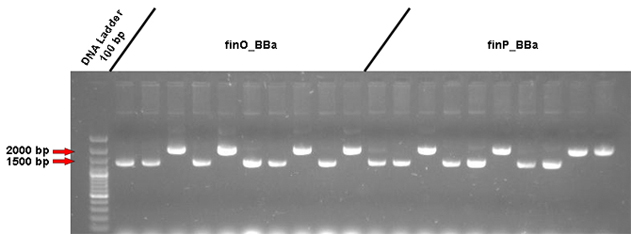Team:UNICAMP-Brazil/Notebooks/September 15
From 2009.igem.org
(→finO and finP's cultures miniprep) |
(→PY Promoter - PY + BBa_J23100 ligation) |
||
| (8 intermediate revisions not shown) | |||
| Line 9: | Line 9: | ||
*<p style=”text-align:justify;”>The cultures grew well and were used to perform the miniprep for F plasmid's extraction, according to [https://2009.igem.org/Team:UNICAMP-Brazil/Protocols/Mini-Prep Protocol 2].</p> | *<p style=”text-align:justify;”>The cultures grew well and were used to perform the miniprep for F plasmid's extraction, according to [https://2009.igem.org/Team:UNICAMP-Brazil/Protocols/Mini-Prep Protocol 2].</p> | ||
*<p style=”text-align:justify;”>The resulting product of the performed miniprep was applied to an 0,8% agarose gel to verify if it went well. Two bands showed up in the gel, with the largest appearing to be a 23 kb fragment. The lower molecular weight fragment, showing to be approximately a 21 kb fragment, is the supercoiled F plasmid that results from the miniprep protocol.</p> | *<p style=”text-align:justify;”>The resulting product of the performed miniprep was applied to an 0,8% agarose gel to verify if it went well. Two bands showed up in the gel, with the largest appearing to be a 23 kb fragment. The lower molecular weight fragment, showing to be approximately a 21 kb fragment, is the supercoiled F plasmid that results from the miniprep protocol.</p> | ||
| - | *<p style=”text-align:justify;”>The next step is to perform the enzymatic digestion of the extracted F plasmid with the | + | *<p style=”text-align:justify;”>The next step is to perform the enzymatic digestion of the extracted F plasmid with the ''Hind''III enzyme.</p> |
''Gabriel'' | ''Gabriel'' | ||
| - | |||
====finO and finP's cultures miniprep==== | ====finO and finP's cultures miniprep==== | ||
| Line 23: | Line 22: | ||
[[image:minipreps1509_bbfinO_bbfinP.jpg]] | [[image:minipreps1509_bbfinO_bbfinP.jpg]] | ||
| - | *<p style=”text-align:justify;”>According to the picture, we recovered plasmids on all samples, with | + | *<p style=”text-align:justify;”>According to the picture, we recovered plasmids on all samples, with considerable amounts of genomic DNA. However, it's not possible to confirm whether those plasmids actually contain our inserts solely by this gel analyses. A PCR procedure must be made.</p> |
| - | *<p style=”text-align:justify;”>As we speculated early, each sample whose inocula showed the red coloration resulted in a band of higher size(about 2000 bp) compared to those with normal inocula coloration. This prove the religation between the digested vector and it's part (RFP device).</p> | + | *<p style=”text-align:justify;”>As we speculated early, each sample whose inocula showed the red coloration resulted in a band of higher size (about 2000 bp) compared to those with normal inocula coloration. This prove the religation between the digested vector and it's part (RFP device).</p> |
''Marcelo'' | ''Marcelo'' | ||
| + | ==== PY Promoter - PY + BBa_J23100 ligation ==== | ||
| + | |||
| + | *<p style=”text-align:justify;”>After the purification of BBa_J23100 from the gel we performed the SAP Dephosphorylation Protocol ([https://2009.igem.org/Team:UNICAMP-Brazil/Protocols/SAP_Dephosphorylation Protocol 9]) to dephosphorylate the 5'-ends of the digested plasmid. It is necessary because the restriction enzymes ''Xba''I and ''Spe''I produces compatible cohesive ends, so the plasmid digested by this enzymes can religate.</p> | ||
| + | |||
| + | *<p style=”text-align:justify;”>After the dephosphorylation we performed the ligation of PY1 + BBa_J23100 and PY2 + BBa_J23100 for an O/N period, according to [https://2009.igem.org/Team:UNICAMP-Brazil/Protocols/T4_DNA_Ligase Protocol 11].</p> | ||
| + | |||
| + | ''Fabi and Léo'' | ||
{{:Team:UNICAMP-Brazil/inc_rodape}} | {{:Team:UNICAMP-Brazil/inc_rodape}} | ||
Latest revision as of 02:37, 22 October 2009
| ||||||||||||||||||||||||||||||||||
 "
"















